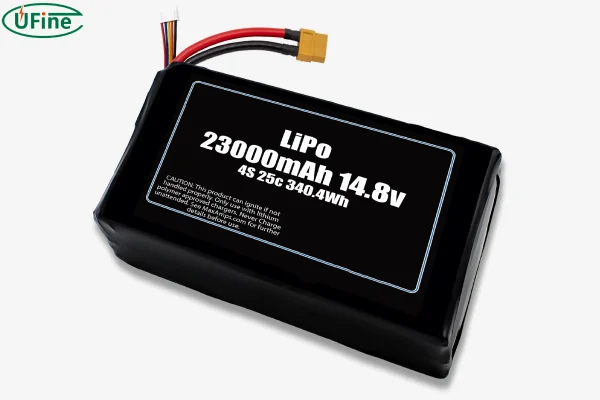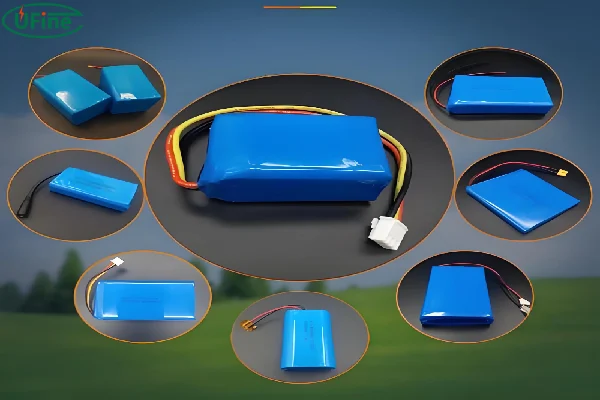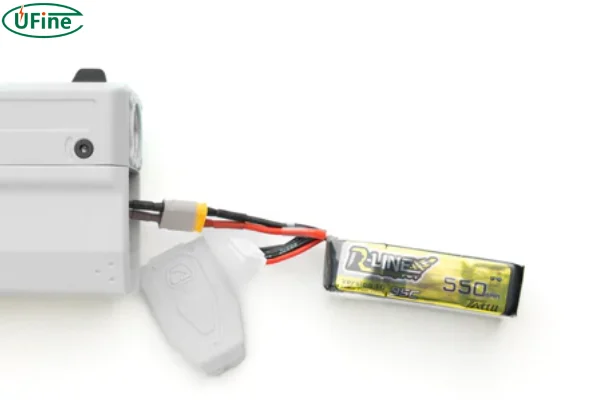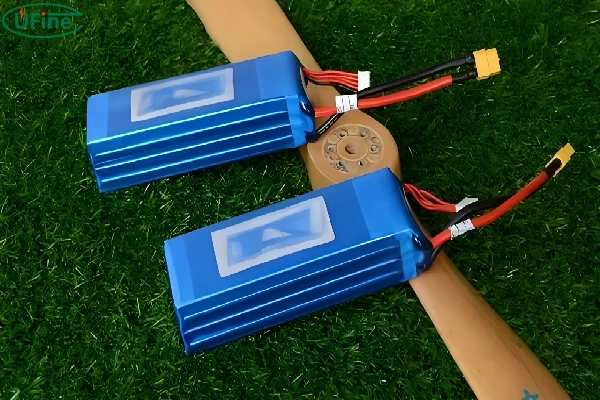Part 1. Introduction to 4S lipo batteries

4S Lipo batteries have become increasingly popular in various applications due to their high energy density, lightweight nature, and reliable performance. These batteries, composed of lithium polymer cells, are preferred in fields such as remote-controlled hobbies, drones, and electric vehicles. Understanding the key characteristics and functionalities of 4S Lipo batteries can significantly enhance their usage and longevity.
What is a 4S Lipo Battery?
A 4S Lipo battery consists of four individual lithium polymer cells connected in series. Each cell typically has a nominal voltage of 3.7 volts, leading to a total nominal voltage of 14.8 volts for a 4S configuration. The voltage range, however, can fluctuate:
- Fully charged: Approximately 16.8 volts (4.2 volts per cell).
- Fully discharged: Approximately 12-13 volts (3-3.25 volts per cell).
Key Features
For users looking to leverage Lipo batteries optimally, understanding their key features is crucial:
- High Energy Density: Lipo batteries offer a great balance of energy and weight, allowing devices to run longer without adding unnecessary bulk.
- C-Rate (Discharge Rate): This indicates how quickly the battery can discharge its energy without degrading its performance. For example, a 30C battery can discharge at 30 times its capacity rate.
- Voltage Stability: These batteries maintain stable voltage levels, essential for maintaining consistent power supply to devices.
- Customizability: Various configurations and capacities are available to meet specific power requirements and constraints.
Safety Concerns
Despite their numerous benefits, 4S Lipo batteries require careful handling:
- Charging: Always use a balance charger specifically designed for Lipo batteries. Overcharging can lead to fires or explosions.
- Storage: Store batteries in a cool, dry place away from flammable materials. Use Lipo-safe bags or containers.
- Usage: Avoid over-discharging, as this can cause irreversible damage to the cells.
Applications
4S Lipo batteries are widely used in:
- Aerial Drones: Provide long flight times and high power output.
- Remote-Controlled Cars and Boats: Offer quick acceleration and high speeds.
- Electric Bikes and Scooters: Deliver reliable and extended ride times.
- Portable Electronics: Used in various gadgets due to their compact size and high capacity.
Understanding these aspects allows users to harness the full potential of 4S Lipo batteries effectively and safely.
Part 2. Understanding lipo battery ratings
To effectively utilize 4S Lipo batteries, it is crucial to understand their ratings. These ratings indicate battery performance, safety, and compatibility with specific applications.
1. Voltage Rating
- Nominal Voltage: Each cell in a Lipo battery typically has a nominal voltage of 3.7 volts. Hence, a 4S (4-cell) Lipo battery will have a nominal voltage of 14.8 volts (3.7V x 4).
- Fully Charged Voltage: When fully charged, each cell can reach up to 4.2 volts, making the fully charged voltage of a 4S Lipo battery 16.8 volts (4.2V x 4).
- Safe Discharge Voltage: It is recommended not to discharge Lipo cells below 3.0 volts to prevent damage, meaning a 4S Lipo battery should not fall below 12 volts (3.0V x 4).
2. Capacity Rating
- Measured in milliampere-hours (mAh), this rating signifies the total charge the battery can hold.
- A higher capacity (e.g., 5000mAh) indicates a longer runtime compared to a lower capacity (e.g., 2200mAh) for the same applications.
- Users need to balance capacity with weight and size, especially for aerospace and mobile robotics applications.
3. Discharge Rating (C-Rating)
- The C-rating indicates the maximum safe continuous discharge rate.
- For instance, a 30C 2200mAh Lipo can continuously discharge 66 amps (30 x 2.2).
- Burst discharge rate, generally higher than the continuous rating, can only be sustained for short periods (usually a few seconds).
4. Configuration
- The “4S” nomenclature denotes the series configuration of cells within the battery pack, meaning 4 cells connected in series.
- Series connections increase voltage while maintaining the same capacity as a single cell.
5. Internal Resistance
- Lower internal resistance enhances battery efficiency and lifespan.
- High internal resistance can lead to higher heat generation and reduced performance.
Comprehending these ratings ensures correct battery selection and optimal performance. Always cross-reference the ratings with the requirements of the device in use to ensure compatibility and safety.
Part 3. Why choose a 4S lipo battery?
Understanding the benefits of opting for a 4S Lipo (Lithium Polymer) battery is crucial for anyone involved in electronics, particularly in areas like remote-controlled (RC) vehicles, drones, and other high-drain devices.
Enhanced Performance
A 4S Lipo battery, with its four cells connected in series, offers a nominal voltage of 14.8V. This results in superior power output and performance compared to lower cell configurations. Higher voltage means:
- Increased Speed: Devices such as RC cars, boats, and drones can achieve higher speeds.
- Improved Thrust: Enhanced motor efficiency produces greater thrust, beneficial for aerial devices.
Weight to Power Ratio
Lipo batteries are known for their exceptional weight-to-power ratio. The 4S configuration maintains this balance, making it ideal for applications where weight is a critical factor. This translates to:
- Longer Flight Times: Drones can stay airborne longer without compromising performance.
- Higher Agility: Lightweight batteries contribute to the nimbleness of RC vehicles.
Charging Efficiency
4S Lipos are designed to handle high discharge rates and can be charged more efficiently. Key aspects include:
- Fast Charging: Reduced downtime due to quicker charging cycles.
- Discharge Rates: Consistent voltage output even under high drain conditions ensures reliable performance.
Durability and Longevity
These batteries are built to endure multiple charge and discharge cycles while maintaining capacity. Features that enhance longevity include:
- Robust Construction: Minimizes the risk of swelling and physical damage.
- Advanced Chemistry: Reduces capacity loss over time, ensuring long-term usability.
Compatibility
4S Lipo batteries are frequently compatible with a wide range of devices. The versatility includes:
- Wide Applicability: Suitable for high-performance drones, RC vehicles, and many other electronics.
- Modularity: Flexible enough to be used in custom applications where power and size configurations are predetermined.
Key Considerations
Using a 4S Lipo battery involves specific considerations:
- Safety Precautions: Proper handling and storage to avoid hazards such as fire or explosion.
- Maintenance: Regular checks for swelling, discharge rates, and voltage levels to extend lifespan.
Choosing a 4S Lipo battery provides significant advantages in terms of performance, efficiency, and versatility, making it an optimal choice for high-demand applications.
Part 4. Common applications of 4S lipo batteries
4S LiPo batteries are a popular choice in various industries due to their efficiency, power output, and versatility. The applications span several fields, each leveraging the unique properties of these batteries to meet specific needs.
Hobbyist Drones and Racing Quadcopters
- Speed and Agility: Racing quadcopters, also known as FPV (First Person View) drones, require high power to perform rapid maneuvers. The 4S LiPo battery provides the necessary voltage, enhancing the drone’s speed and agility.
- Flight Time: For hobbyist drones, these batteries offer a balanced trade-off between extended flight time and performance, making them ideal for both recreational and competitive flying.
- Weight Management: The weight-to-energy ratio is critical for drones. 4S LiPo batteries provide a lightweight solution without compromising on power.
Remote Control (RC) Vehicles
- RC Cars and Trucks: The power output of 4S LiPo batteries makes them suitable for high-performance RC cars and trucks, enabling faster acceleration and higher top speeds.
- Boats: In RC boating, these batteries deliver the necessary thrust for quick movements on water, enhancing the racing experience.
- Endurance: The batteries support extended runtime, which is particularly beneficial in endurance-based RC activities.
Electric Flight
- Model Aircraft: 4S LiPo batteries are commonly used in electric flight models, providing the necessary energy for sustained and powerful flight.
- Helicopters: For electric helicopters, these batteries supply the needed power for complex aerobatic maneuvers and stable hover capabilities.
- Gliders: In electric gliders, they contribute to longer flight durations and reliable performance during critical phases like takeoff and climbing.
Robotics and DIY Projects
- Educational Robots: In educational settings, robots powered by 4S LiPo batteries can perform more intensive tasks, helping students understand advanced robotics concepts.
- DIY Electronics: Makers and hobbyists often use these batteries in DIY electronics projects due to their compact size and reliable power output.
- Prototyping: Engineers and developers employ 4S LiPo batteries for prototyping new devices, as they offer a convenient and powerful energy source.
Professional Use
- Surveying Drones: Professional surveying and mapping drones rely on 4S LiPo batteries for extended flights and high-efficiency power systems.
- Aerial Photography: In aerial photography, these batteries support heavy payloads like cameras and stabilizers, ensuring smooth and prolonged operations.
- Industrial Applications: Various industrial applications, including inspection drones and automated systems, utilize 4S LiPo batteries for their robustness and energy density.
By understanding these applications, users can better appreciate the versatility and power of 4S LiPo batteries.
Part 5. Choosing the right 4S lipo battery for your needs
Selecting the appropriate 4S Lipo battery involves considering several critical factors to ensure optimal performance and longevity. Buyers must evaluate their specific needs and requirements to make a well-informed decision.
Capacity and Discharge Rate:
-
Capacity is measured in milliampere-hours (mAh). Higher capacity translates to longer flight times or extended run times. Users looking for prolonged usage should opt for higher capacity batteries.
-
Discharge rate, denoted as ‘C’ rating, indicates how quickly the battery can deliver power. Applications requiring high bursts of power, such as racing drones, need a higher C rating, commonly in the range of 50C to 100C or more.
Voltage Compatibility:
- Ensure the 4S (four cells) configuration, providing a nominal voltage of 14.8V, aligns with the voltage requirements of the equipment. Compatibility with the power system is crucial for safety and performance.
Weight Considerations:
- Heavier batteries offer higher capacity but may impede performance, especially in aerial applications where reduced weight enhances agility and flight dynamics.
Connector Type:
- Battery connectors, such as XT60, EC5, and Deans, should match the equipment’s power inputs. Using the correct connector minimizes resistance and ensures a secure connection.
Size and Fit:
- Physical dimensions of the battery need to fit the battery compartment of the device. Measuring the available space and comparing it to the battery dimensions is essential to avoid any fitting issues.
Brand and Quality:
- Opting for reputable brands can provide reliability, better performance, and longer lifespan. Quality assurance eliminates concerns related to durability and safety.
Price and Budget:
- Balancing the required specifications within the budget constraints is necessary. High-end batteries provide better performance but at a higher price. Evaluating cost-effectiveness based on usage frequency and requirements should be considered.
Usage Environment:
- Consider the operating environment. Extreme temperatures can impact battery performance and life. For outdoor and harsh conditions, select batteries specifically designed for such environments.
Charging Specifications:
- Verify the recommended charging specifications. Some batteries support faster charging, reducing downtime but necessitating appropriate chargers.
Customer Reviews and Ratings:
- Reading product reviews and ratings can provide insights into the real-world performance and reliability of the battery.
By meticulously evaluating these factors, buyers can select a 4S Lipo battery that meets their specific needs and ensures high performance and safety.
Part 6. Safety precautions when using 4S lipo batteries
Using 4S Lipo batteries requires strict adherence to safety precautions to prevent potential hazards such as fire, explosion, or personal injury. The following points outline essential safety measures:
-
Inspection Before Use:
- Always inspect the battery for physical damage, swelling, or punctures before use.
- Ensure connectors and wires are intact and not frayed.
-
Proper Charging Practices:
- Use a designated Lipo balance charger capable of handling a 4S configuration.
- Never charge unattended or overnight.
- Adhere strictly to the recommended charging rates; avoid exceeding the manufacturer’s voltage and current limits.
-
Storage Guidelines:
- Store batteries in a cool, dry place, inside a fire-proof container or Lipo-safe bag.
- Avoid storing fully charged or fully depleted batteries for extended periods; store at 50-60% charge.
-
Handling and Usage:
- Refrain from exposing batteries to extreme temperatures, water, or direct sunlight.
- Do not pierce, burn, or apply excessive force to the battery.
- Ensure batteries are secure and unlikely to shift during use to prevent damage.
-
Disposal:
- Do not dispose of in regular trash.
- Follow local regulations for hazardous materials, and use designated recycling centers where applicable.
-
Incident Response:
- If a battery emits smoke, hisses, or swells, move it to a fire-resistant area and monitor it from a safe distance.
- Have a Class D fire extinguisher or sand nearby when charging or using batteries.
-
Battery Compatibility:
- Use batteries that match the device specifications.
- Avoid mixing old and new batteries or different brands.
-
Personal Protective Equipment (PPE):
- Wear safety glasses and gloves when handling damaged or swollen batteries.
- Consider additional protective equipment if performing extensive battery maintenance.
Part 7. Proper charging techniques for 4S lipo batteries
Balancing the Battery
Balancing ensures that each cell in the 4S Lipo battery maintains the same voltage. Unbalanced cells can lead to reduced performance and potential hazards.
- Use a balance charger specifically designed for Lipo batteries.
- Connect the balance plug to the charger to monitor individual cell voltages.
- Set the charger to ‘Balance Charge’ mode for proper charging.
Setting the Correct Charging Parameters
Using improper settings could damage the battery or reduce its lifespan.
- Charge Rate: Use a charge rate consistent with the battery’s ‘C’ rating. For example, a 3000mAh battery with a 1C rating should be charged at 3A.
- Voltage: Ensure that the charger is set to the correct voltage for a 4S battery, which is 14.8V.
Charging Process
To safely charge a 4S Lipo battery, a consistent and methodical approach should be implemented.
- Place the battery on a non-flammable surface, away from flammable materials.
- Connect the main charge leads and the balance plug to the charger.
- Select the appropriate battery type (Lipo), cell count (4S), and charge rate.
- Initiate the charging sequence, frequently monitoring the charger display for any irregularities.
Monitoring Temperature
Temperature control is crucial during the charging process to prevent thermal runaway.
- Temperature Monitoring: Use a charger with an integrated temperature sensor, or manually check the battery’s temperature.
- Temperature Threshold: Maintain a temperature below 45°C (113°F) during charging.
Safety Precautions
Adhering to safety precautions reduces the risk of accidents and extends the lifespan of the battery.
- Fireproof Bag: Charge the battery inside a Lipo-safe bag to contain any potential fire.
- Supervision: Never leave the battery unattended during charging.
- Inspection: Regularly inspect for any signs of swelling, damage, or unusual heat before charging.
Post-Charge Care
Proper handling after charging is essential for maintaining battery health.
- Cool Down: Allow the battery to cool before use or storage.
- Storage Voltage: If not immediately in use, discharge the battery to a storage voltage (approximately 3.8V per cell).
By adhering to these techniques, the longevity and safety of a 4S Lipo battery can be maximized, ensuring optimal performance and minimizing risks.
Part 8 . Maintaining and storing 4S lipo batteries
Proper maintenance and storage are crucial for the longevity and safety of 4S Lipo batteries. The following guidelines provide essential information to ensure optimal performance.
Maintenance Tips
-
Regular Inspection
- Check for any visible damage or swelling before and after each use.
- Inspect the wiring, connectors, and balance leads for any signs of wear or damage.
-
Balancing Cells
- Use a quality Lipo balance charger to ensure all cells maintain equal voltage levels.
- Regularly balance charge to prevent overcharging or undercharging individual cells.
-
Cleaning
- Clean connectors with a contact cleaner to prevent oxidation.
- Wipe down the battery casing with a dry cloth to remove any dust or debris.
-
Discharging
- Avoid discharging below 3.0V per cell to prevent irreversible damage.
- Use a Lipo discharge capable charger or resistor for consistent and safe discharging.
-
Temperature Management
- Monitor the battery temperature during charging and usage. Ideal operating temperatures range between 20°C and 45°C.
- Allow the battery to cool down before recharging to prevent overheating.
Storage Guidelines
-
Charge Level
- Store batteries at a 50% to 60% state of charge. This typically corresponds to around 3.8V per cell.
- Utilize the storage mode on Lipo chargers to achieve the appropriate charge level.
-
Environment
- Store in a cool, dry place, away from direct sunlight and heat sources. Ideal storage temperature is between 5°C and 25°C.
- Use a fireproof Lipo storage bag or a metal container to mitigate the risk of fire.
-
Regular Checks
- Inspect stored batteries every month for any signs of swelling, leakage, or other damage.
- Rebalance as needed if voltage discrepancies between cells are detected.
-
Avoid Magnetic Fields
- Keep batteries away from strong magnetic fields which can interfere with their internal chemistry and electronics.
By adhering to these maintenance and storage practices, users can extend the lifespan of their 4S Lipo batteries and ensure the safe and efficient performance of their equipment.
Part 9 .Troubleshooting common issues with 4S lipo batteries
Numerous issues may arise when dealing with 4S Lipo batteries. Understanding common problems and their solutions is critical for maintaining battery health and performance.
Overheating
Overheating can damage a 4S Lipo battery. Potential causes include overcharging, high discharge rates, and inadequate cooling.
- Check charging practices: Ensure chargers are used correctly and within specifications.
- Monitor discharge rates: Avoid drawing more current than the battery is rated for.
- Enhance cooling: Utilize heat sinks or cooling fans if necessary.
Swelling or Puffing
Swelling, also known as puffing, indicates internal damage or chemical instability.
- Inspect for damage: Check for visible physical damage or signs of misuse.
- Follow usage guidelines: Adhere to recommended charging and discharging practices.
- Dispose if necessary: Properly dispose of badly swollen batteries.
Voltage Imbalance
Voltage imbalance among cells can reduce battery efficiency and lifespan.
- Balance charging: Use a balance charger to ensure cells are charged evenly.
- Regular checks: Periodically check individual cell voltages.
- Manual balancing: Manually discharge higher voltage cells if required.
Connection Issues
Poor connections can lead to power loss or intermittent failure.
- Inspect solder joints: Verify all solder connections are intact.
- Check connectors: Ensure both connectors and wiring are secure.
- Clean contacts: Remove any debris or oxidation from connectors.
Rapid Discharge
Experiencing abnormally fast discharge might indicate underlying problems.
- Review usage: Avoid excessive current draw and improper battery loads.
- Test for firmware issues: Verify that device firmware and settings are appropriate.
- Evaluate health: Consider replacing the battery if performance degradation persists.
Storage Problems
Improper storage can shorten battery lifespan.
- Store at optimal voltage: Maintain a storage charge of approximately 3.8V per cell.
- Control environment: Store in a cool, dry place.
- Periodically check: Regularly monitor battery voltage during long-term storage.
Leakage
A leaking battery poses significant dangers.
- Immediate isolation: Safely isolate the leaking battery.
- Cleanup: Follow appropriate hazardous material cleanup procedures.
- Replacement: Replace the battery immediately.
Conclusion
Proper maintenance minimizes 4S Lipo battery issues, ensuring safety and longevity.
Part 10.Tips for extending 4S lipo battery life
To maximize the lifespan of a 4S Lipo battery, follow these essential tips:
Proper Charging Practices
- Use a Balanced Charger: Employing a balance charger ensures each cell within the battery is charged evenly, helping to prevent overcharging or undercharging individual cells.
- Set Correct Charging Rates: Always follow the manufacturer’s recommended charging rates. Typically, charging at 1C is considered safe, but always refer to the specific battery specifications.
- Avoid Overcharging: Do not charge the battery above 4.2V per cell. Overcharging can lead to swelling, overheating, and potentially fire.
Safe Storage
- Store at Correct Voltage: For long-term storage, keep the battery at a storage voltage of approximately 3.8V to 3.85V per cell to reduce stress on the cells.
- Use Storage Mode on Charger: Many balance chargers have a storage mode setting to automatically bring the battery to a safe voltage level for storage.
- Cool, Dry Environment: Store batteries in a cool, dry place away from direct sunlight and extreme temperatures to prevent degradation and potential hazards.
Handling and Usage
- Avoid Deep Discharges: Do not discharge the battery below 3.0V per cell. Deep discharging can cause irreversible damage and reduce overall lifespan.
- Monitor Temperatures: During use, ensure that the battery does not overheat. Excessive heat can reduce the life and efficiency of the battery. Post-flight, allow the battery to cool before charging.
- Use Voltage Alarms: Voltage alarms can alert the user if the battery voltage drops to unsafe levels during use, allowing timely intervention.
Regular Maintenance
- Check for Damage: Regularly inspect the battery for signs of physical damage, swelling, or leakage. Dispose of damaged batteries responsibly.
- Cycle the Battery: Occasionally cycle the battery by fully charging and discharging it to recalibrate the cells and improve performance.
- Balance Charge Regularly: Even if not frequently used, occasionally balance charge the battery to maintain cell health.
By adhering to these tips, users can significantly extend the lifespan and maintain the efficiency of their 4S Lipo batteries. Proper care not only ensures better performance but also enhances safety.
Related Tags:
More Articles

How to Choose the Best Floor Scrubber Battery for Commercial Cleaning?
Selecting the ideal floor scrubber battery ensures a long runtime, rapid charging, and minimal maintenance for efficient commercial cleaning operations.
Battery for Blower vs Battery for Leaf Vacuum: Which One Should You Choose?
Battery for blower vs leaf vacuum—learn the key differences in power, fit, and runtime to choose the right battery for your outdoor tool needs.
How to Choose the Right Battery for Blower?
Choosing the right blower battery? Consider voltage, capacity, chemistry & usage. This guide helps match the best battery for peak performance.
How to Choose the Best Insulated Battery Box for Lithium Batteries?
Choosing the Best Insulated Battery Box for Lithium Batteries? Discover key factors such as size, material, and safety for optimal protection and performance.
7 Critical Elements on a Lithium Battery Shipping Label
What must be on a lithium battery shipping label? Learn 7 key elements to ensure safety, legal compliance, and correct handling across all transport modes.






